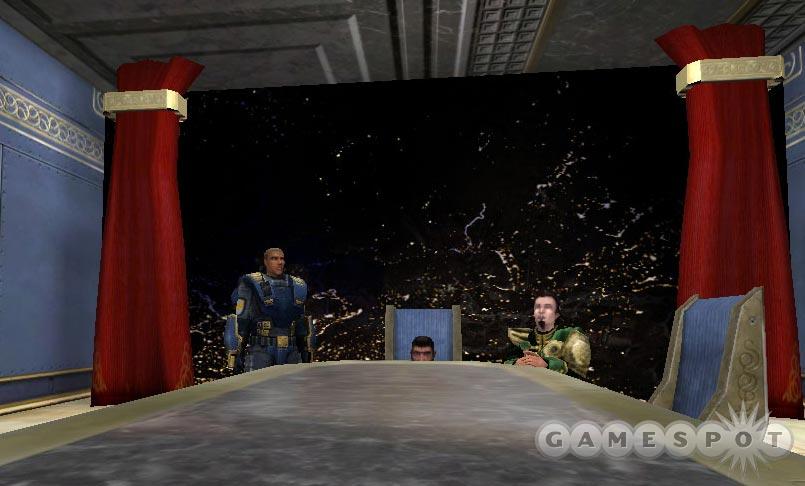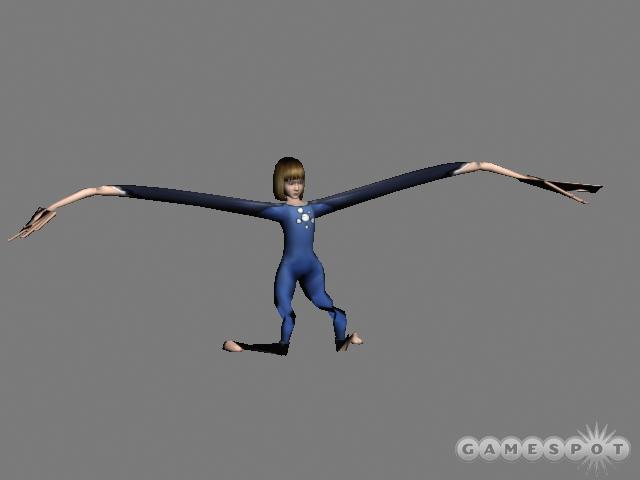Tribes: Vengeance Updated Q&A - Animating Tribes
Senior Animator Ben Hutchings tells us how the characters in Tribes: Vengeance were made.
Before there was Battlefield 1942, there was Starsiege Tribes, the seminal team-based shooter that ushered in a new era of online gameplay. Tribes introduced a couple of features that we now take for granted, including massive levels to run around, as well as player-controllable vehicles. Now Irrational Games is readying Tribes: Vengeance, the third game in the franchise and from what we've seen so far, it looks to be every bit as fast-paced and engaging as its predecessors. But Irrational is doing far more than simply introducing a new graphics engine (the game uses the latest Unreal engine technology); in order to make Tribes more appealing to mainstream gamers, Irrational is also incorporating a single-player campaign, which is a first for the series. The previous two Tribes games were multiplayer-only affairs, but Tribes: Vengeance promises to correct that with what should hopefully be an intriguing and involving story. We had the opportunity to ask Ben Hutchings, the game's senior animator, how the company went about creating the unique characters and the numerous cutscenes in the game.

GameSpot: Tell us about how Tribes: Vengeance's story will be told throughout the single-player game.
Ben Hutchings: As you know, one of the most distinctive features of Tribes: Vengeance is that it contains a story, quite a big story actually, told in a series of animated cutscenes. These appear between levels, and I like to pretend that the levels are merely little immersive bits to make the cutscenes even more rockin'.
From the cutscene team's point of view, the story is incredibly complex. There are seven major characters, each with different versions depending on the era of the particular scene or which outfit the character is wearing. Add to this the cast of secondary characters who only appear in a few scenes, and then finally the extras: troopers from different Tribes, different sexes, and different armor classes. Oh yeah, and all the civilians and the vehicles.
GS: And how does character animation figure into creating the story?
BH: Each character has a unique animation sequence for every shot in which he or she appears. Some repetitive sequences may be used more than once within a scene, but very rarely! This wasn't the original plan, of course, but it proved necessary in order to make the body language fit the characters' dialogue well. Several cutscenes take place within a small area of the gameplay map, but many cutscenes have a unique environment created specifically for the scene. Add to this the amount of cutscene-specific props, and you can see why we require a mighty team who devote themselves completely to the creation of this animated epic.
GS: Tell us how the team has gone about creating the characters of Tribes: Vengeance.
BH: Rowan [Wyborn] and David [Beswick] produced this very nifty little program called Mojo, specifically designed to compile and play cutscenes. It is here that all the characters, sounds, animations, and sets are brought in and work begins on setting up the shots according to the storyboards. Each character has its own set of tracks devoted to its speech, animation, position and effects, such as the jetpack flare. Mojo also makes use of effects, like motion blur, slow motion, and overlays for text and such. This paragraph on Mojo is being kept small. I can't begin talking about Mojo without devoting another two pages to it, since it is where we do about half of our work!
The rest is done in 3D Studio. I've spent the past six or so years of my life in its gray environment, liaising with strange blue and green figures upon an infinite grid of black lines. This is where all the assets for Tribes: Vengeance are made. I might keep this paragraph really short too, because it's making me depressed. Setting the background color from gray to blue helps not one jot. I hope we can work on a Mario game next.

I think about 40 percent of the animation you will see in the cutscenes will be motion-captured sequences. This was all done over several days up in Sydney at the now-expired Madcap Studios using a few local actors, plus Michael Johnson and Ben Lee. One by one, we got the poor actors to stand out in the middle of some crash mats in their fetching scuba suits, covered in stupid little sensor balls. Ben would then explain to them that in this shot Victoria has just been told a hilarious bra joke and so she laughs, and then cries because it is true. Someone cries "Action!" and the actor begins to laugh and cry as the sensors all around the room record the movements of all the little sensor balls attached to the actor. "Cut!" and we begin talking about the next shot. This took several days. The last day was cool because we broke out the crash mats and trampoline so that we could act out some "getting blown up by spinfusors" and "being riddled with bullets" sequences.
GS: What are some of the challenges you've faced in the game's development?
BH: Trying to match the natural look of motion-capture with my own hand animation has been a real test of my abilities. But we never stop scanning the scenes again and again and no less-than-awesome animation shall ever slip past our critical eyes. Ben, Dan [Cermak], and I are very cynical and a ruthlessly critical bunch, so it's immensely satisfying to watch a whole scene and find that there's nothing to pick on. It's even better when someone cries "WOAAAAAH!" without meaning to because they were just too blown away.
Tribal Motions
GS: How are you making the game's characters come to life?BH: People's eyes are accustomed to watching human movement. So much so that we could recognize the particular walk of a good friend even from a distance, or we might sense a person's state of mind by the speed with which the head is turned, or by that person's gait if he had wet his pants and was trying to hide it. We are very sharp when it comes to watching and interpreting movement in people.

I don't think we ever make a movement which smoothly progresses for more than half a second. Our brains are constantly updating every trajectory and rotation our limbs make. When I raise my hand to pick my nose for instance, the trajectory my hand follows is not a straight line, nor is it a smooth arc. The rate at which my hand approaches my nose is not constant either.
But computer animation by default is made up of smooth transitions which, if the animator is lazy, result in that classic underwater, "floaty" look you see in a lot of animations. A cutscene looks rotten if a character suddenly adopts that terrible floaty look all of a sudden. Which, to be fair, is very difficult to suppress. Even something like a simple head turn needs quite a few key frames. If it is nothing but a "start looking left" which then transitions to a "looking right" pose, it will look unnatural and robotic. An ease into the motion, perhaps a slight dip of the head, an ease out to a stop, and maybe a slight return reaction at the end is much better. A very subtle turn of the torso to go with it often adds that extra pizzazz.
What if a character is just standing there listening? It is important for when you don't want the person who is not talking to be dancing. Off the top of my head I couldn't think of a single thing a person actually does when standing still. Obviously a person would scratch, look around and such, but only occasionally. Watching people during our Monday morning meetings is helpful. I noticed that apart from the occasional fisticuffs and break dancing, people generally just breathed and shifted their weight when their legs got tired. There is a lot of eye movement, blinking, and small amounts of head movement, but not much else. This is enough to give characters life without making them look restless or like they are overacting.
I have a cool little camera here on my monitor. I don't know who owns it, but that person isn't getting it back. If I ever need to figure out a sequence I can act it myself, and watch each body part to see just how each limb moves during say, a get-up-off-the-ground-after-being-conked-on-the-head sequence. The AVIs I've amassed of myself moving about are highly amusing and would make great cutscenes in themselves. Nah, not really.
GS: What goes into making an actual character?
BH Ok, so what's the process of making these things anyway? It all starts with Ben Lee's storyboards. Once we had them we had to sit around trying to figure out how we were going to achieve the kinds of effects we wanted. Many of these ideas had to be ditched very early on so that we didn't spend weeks trying to get a tear to trickle out of an eye when we could have been making cooler stuff like exploding heads and such. Once that's all nutted out then the animation work can begin. We do several passes on the cutscenes throughout the entire project:
First pass: This involves putting the characters in the set, inserting the dialogue and animating the cameras to fit the storyboard. This results in rough versions of the scenes, and from here we can figure out if the scene is going to work or not. These rough scenes also let you know how long each animation sequence needs to be before the camera cuts away and the character can safely stand stone still. The sets are all pretty quickly compiled and there is no proper lighting. We also start to think up certain features Mojo is lacking and we harass the programmers accordingly.
Second pass: Now some half-decent animation is put in, including a lot of the mocap. Some of it is temporary hand animation, and a lot of the dialogue is still temporary too. The characters move, but their faces are eerily emotionless. There will still be changes made to models and the script, so a lot is left unfinished; but at this stage the models are starting to look quite awesome. Some good skyboxes and effects, such as rain and dust, start to give the scenes good atmosphere.
Third pass: We are in third pass as we speak. Dan is giving the characters lip sync, blinks, and emotions while I add final touches to the character animation. For the first time the characters don't look like mannequins! Their eyes actually seem to focus on things. While this is the stage with the most work (after this we won't get a chance to improve anything), it's also the most fun and the most satisfying. So why the hell am I writing this document? Because despite Tribes fans being, you know, the way they are, I do nurture a love for them in my bosom. When you see the game and the animation, hopefully it will be good enough to make you believe me.
Got a news tip or want to contact us directly? Email news@gamespot.com
Join the conversation